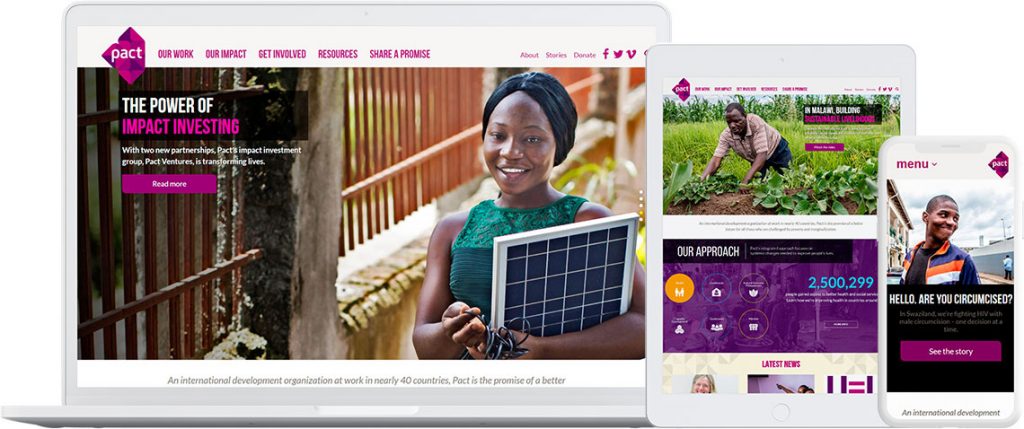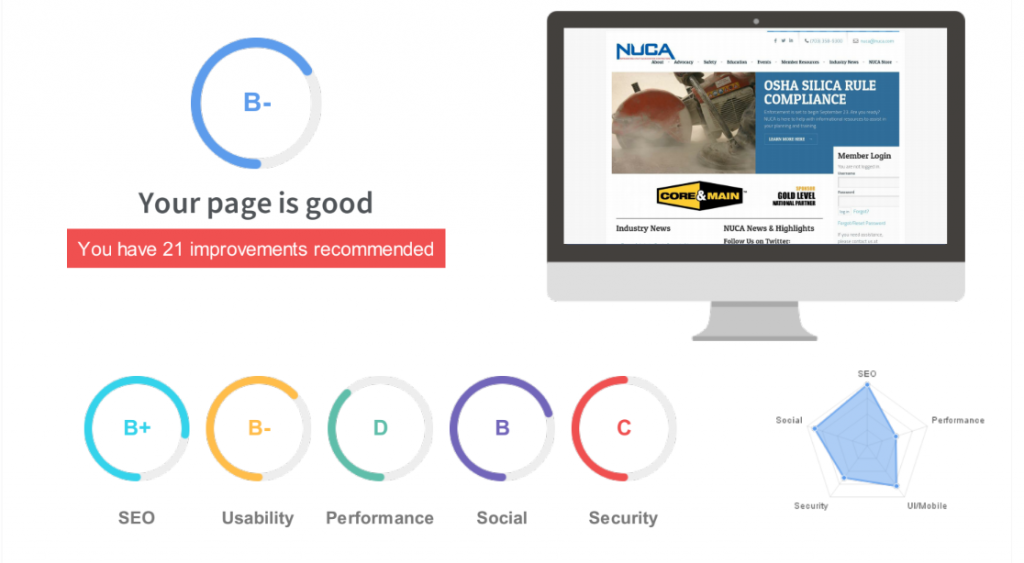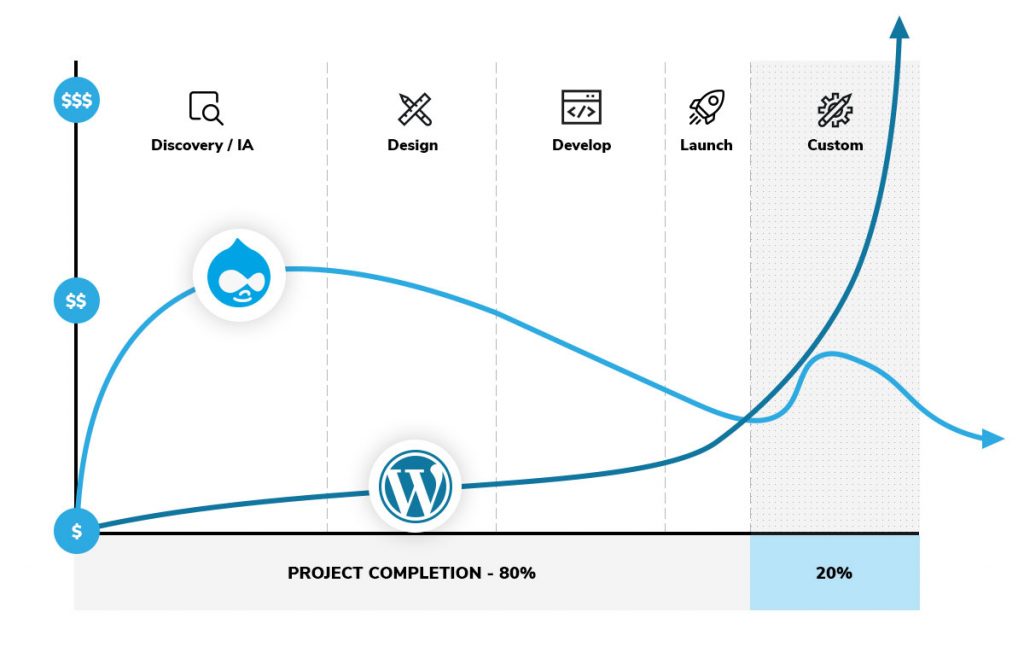If you work for a nonprofit organization, then you understand the need for a website platform that allows you to easily manage content and make updates to keep your audience informed engaged in your mission. Nonprofits and non-governmental organizations (NGOs) also have a need for a secure space for online donations and effective communications management, which is why Drupal makes an excellent choice for a content management system (CMS) platform.
What is Drupal CMS?
The Drupal platform has been known since 2001 as a reliable CMS with fast performance, great security features, and customizable content features, all of which create a dynamic and engaging visitor experience. Drupal was created with developers in mind, and its modular design components allow for virtually endless possibilities for content presentation. Drupal is now used by a diverse community and serves as the foundation for all types of websites from startups, community organizations, and large corporate websites. Due to its flexibility in how content can be presented, Drupal now powers over 1.2 million websites and holds about 3.4% of the market share for CMS platforms.
So Why is Drupal a Great Choice for Nonprofits?
If you are considering upgrading your nonprofit website platform, we recommend Drupal as one of the most reliable investment options. Not only does Drupal offer the flexibility your brand might need to create an eye-catching website, but it also offers a high level of support for your staff through the Drupal community. Below are a number of benefits of Drupal development for nonprofits and NGOs.
Easier Content Management
Providing your nonprofit staff with a simple, user-friendly CMS is one of the best returns on investment that Drupal offers. Your staff will save time and money by having the ability to make frequent updates and adjust content as your organization grows and changes. This type of flexibility allows you to make adjustments to content structure and presentation, as well as navigation. Drupal even offers client-side editing features, allowing site administrators to quickly make adjustments to text or imagery.
Drupal content management not only allows for frequent updates, it also requires minimal training for users, allowing even non-technical staff to assist with updating your nonprofit website. Drupal offers a page manager feature, which gives the ability to create different page layouts and even create landing page design, helping your nonprofit better engage your online visitors. Drupal also helps easily identify different types of content such as text, images, and attachments, making it easy to build a web page.
Organizations like Pact have benefited from Drupal’s ability to easily add content and quickly scale to handle campaigns and other mission critical needs.
A Secure Space for Processing Online Donations
One of the major revenue sources for nonprofits and NGOs is online donations. Drupal allows nonprofits to carry out donation and contribution transactions safely and securely through its high-level security features. Drupal offers different modules that provide these enhanced security features, giving your donors the piece of mind they need to make safe transactions. A few security modules that we would recommend include the Security Kit, Security Review, and Password Protection. There are also a number of modules available through Drupal to set up your online donation system, such as Payment, Paypal Donation, and Donate.
In addition to the security features needed to support these transactions, Drupal’s content flexibility allows for more awareness to be directed to these online donation spaces. Content and navigation can be easily customized on a Drupal website to bring attention to donation areas. On a Drupal website, a developer can easily integrate calls to action to remind visitors that there is an opportunity to give back to your cause. Your donation pages can also be further enhanced on Drupal through inclusion of online video, surveys, and impact statements.
Scalability
Whether your nonprofit is a few people or a few thousand, Drupal has the capability and tools designed to help you grow. Smaller nonprofits can easily benefit from the ease of deploying a small site quickly, while larger organizations can configure sites as software applications running mission critical data.
Unlike many licensed software tools, Drupal has the capability to launch unlimited separate websites — either branded as your primary site or designed to look and feel different from an initial site in what is often referred to as multi-site capability. This gives administrators the ability to control all the ‘child’ websites from one single dashboard interface within Drupal.
Content Flexibility
If your nonprofit or NGO wants to create one of the best user experiences for your online visitors, Drupal is the way to do it. Drupal allows for more content flexibility than any other online platform through the addition of online modules. This allows your nonprofit organization to integrate dynamic and engaging content into your website that will really wow your visitors.
Another example is being able to create website applications within Drupal. For example take a look at PACT’s “Share a Promise” feature on their website. This is a dynamic content space that encourages visitors to interact with the organization by making a commitment or #pactpromise to their community. Below the promise wall is a full video library to give visitors a visual representation of community projects in which they are involved. This website was developed using the Drupal platform.

Enhances Search Engine Functionality
The goal of a nonprofit website or NGO is to educate new visitors on their mission, so they need to be able to drive new traffic from search engines to their site. Optimizing your nonprofit website for search readability will help direct new site visitors that have an interest in your mission or cause. Features on Drupal allow you to easily enhance your content structure on website pages to make your site more search engine friendly.
With the help of other Drupal modules like SEO Checklist, you can even improve local search functionality to drive nearby visitors that may want to get involved with your cause.
Community Support
Drupal offers nonprofit community groups as part of their support system. Check out one of the for nonprofit groups here. This community support gives your nonprofit an area for direct communication with individuals that have a similar set of values that can collaborate together to communicate their mission and create the best possible experience online for their audience. By having a shared space to discuss website-related questions and concerns, your nonprofit or NGO will be able to maximize the use of all Drupal’s great features when setting up your website.
Drupal is a well-supported platform, so your nonprofit organization will also have peace of mind that there are Drupal development solutions available if there is ever a threat or issue on your website. Using a less-supported platform or template design may pose issues down the road if your nonprofit wants to make any future updates, so using a Drupal website may be a more cost effective solution in the long run.
The Cost
The cost of designing, developing, and maintaining a website can vary greatly depending on the complexity of the project and how you host it. When deciding on the platform that you will build on, it’s important to find the most cost-effective solution that accomplish your goals and get your content to your audience.
As cost is often a major factor in the decision-making process, one of the big advantages of Drupal is that its both open source and free of any licenses. The very nature of Drupal’s existence, to give web developers the freedom to create websites without licenses, is one of the major reasons why it has become an attractive option for NGOs and nonprofits.
The Drupal community and private sector contribute to thousands of modules and themes that extend Drupal’s capabilities. Major software developers also integrate their software with Drupal natively allowing your NGO or nonprofit to continue benefiting from and using existing tools built directly into your Drupal website.
The Cost of Continuous Development vs the Groundhog Day Website
While some vendors offer pre-built themes which may look attractive, inexpensive, and easy, they often lack more in-depth capabilities that many nonprofits or NGOs need in the future. That also includes companies that provide websites as a service like Wix and Squarespace, which look great until you discover it may be the wrong fit as you have no control over changes as your organization grows.
As your website continues to grow, so do the fixes and bandages to the code, creating a user experience that’s slow or broken. Often these limitations are discovered too late forcing organizations to abandon their website and wasting valuable resources in search of a better solution.
Drupal gives nonprofits and NGOs a clear path to avoid this ‘GroundHog Day’ scenario and utilize a platform that can benefit from continuous improvements and grow with your organization.
When developing a website properly you want to configure development, staging, testing and production environments that provide version development control.

Continuous improvement within Drupal then enables you to enhance and update your website and reduce costs over time when working with an experienced development team. Following a continuous development cycle also means that your on-site user experience will continue to improve versus an ad-hoc approach that can leave updates looking like they’ve been bolted onto your website.
The Re-Cap
Drupal was created to give organizations the ability to quickly grow, scale, and maintain startup to enterprise-size websites. Drupal offers a lower cost of ownership vs. licensed content management systems and benefits from a community that is continually extending the platform’s capabilities and security. Some of the world’s largest nonprofits and NGOs trust Drupal to handle mission-critical websites. You can browse some of them on Drupal.org. Hopefully this blog post has given you some of the best features of the Drupal enterprise content management system.




